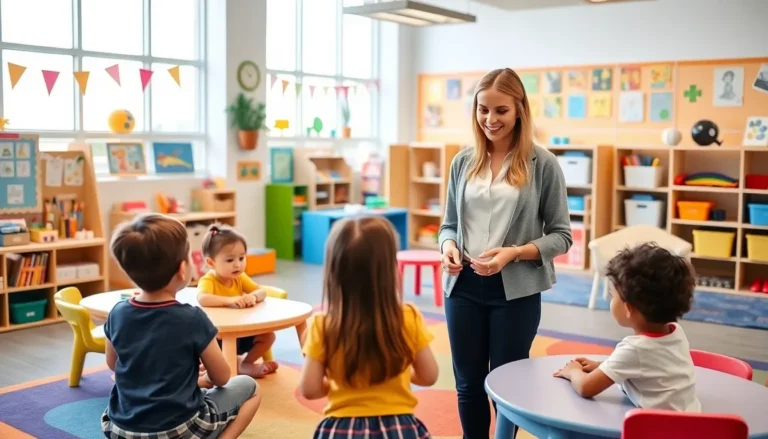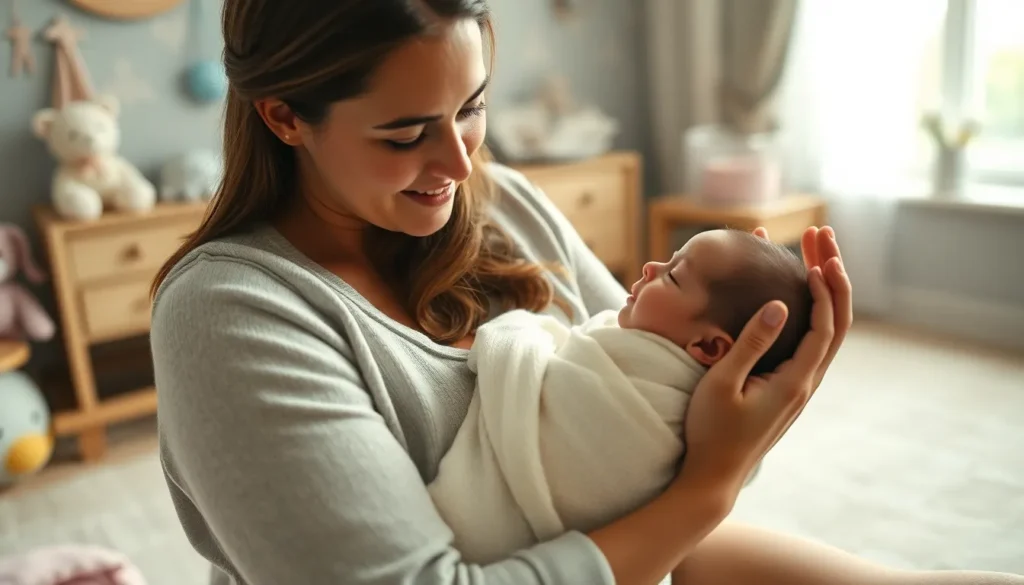Table of Contents
ToggleWelcoming a newborn into the world is a beautiful adventure, but let’s be honest—sometimes it feels more like an episode of a reality show gone rogue. Those tiny humans can go from peaceful angels to wailing tornadoes in seconds flat. Luckily, there’s a treasure trove of calming techniques that can turn chaos into calm faster than you can say “swaddle.”
Understanding Newborn Calming Techniques
Newborns experience a range of emotions and sensations that can lead to distress. Parents can implement various calming techniques to help soothe their infants and foster a peaceful environment.
Importance of Calming for Newborns
Calming techniques play a vital role in a newborn’s development and well-being. Soothing methods promote relaxation and support emotional stability. A peaceful atmosphere aids in reducing stress and anxiety levels in both infants and parents. Effective calming can also enhance sleep quality, which is essential for a newborn’s growth. By implementing these techniques, caregivers can strengthen the emotional bond with their baby, laying a foundation for healthy attachment patterns.
Common Reasons for Newborn Distress
Newborns often exhibit distress due to several common triggers. Hunger consistently stands out as a primary cause. Overstimulation from loud noises or bright lights can easily overwhelm an infant. Discomfort from a wet diaper or tight clothing frequently leads to fussiness. Additionally, tiredness plays a significant role in newborn distress; babies have limited ability to self-soothe when overtired. Recognizing these triggers allows parents to address the root causes of their baby’s discomfort effectively.
Popular Newborn Calming Techniques

Newborns often require calming techniques to ease anxiety and promote relaxation. Parents can choose from several effective methods.
Swaddling
Swaddling involves wrapping a newborn snugly in a blanket to create a sense of security. This technique mimics the snug environment of the womb, helping infants feel more comfortable. Many parents find that swaddled babies sleep longer and quieter. Crucial to this method is ensuring the swaddle is not too tight, which can restrict movement and blood flow. Proper swaddling promotes a calming atmosphere, reducing the startle reflex that may wake a sleeping baby.
White Noise
White noise generates a consistent sound that masks other disruptive noises in the environment. This calming technique mimics the sounds a baby hears in the womb, aiding in relaxation. Various devices or apps can produce white noise, with options like ocean waves, rain, or a gentle hum. Many parents notice their infants become calmer and fall asleep faster when white noise is introduced. Using white noise creates a soothing backdrop that minimizes disturbances, promoting a restful sleep cycle.
Gentle Rocking
Gentle rocking provides a rhythmic motion that can soothe a fussy newborn. This technique resembles the sensations experienced during pregnancy, offering comfort and familiarity. Parents can rock their babies in their arms, a crib, or a swing. Many infants respond positively to the gentle motion, often drifting off to sleep quickly. Consistent rocking sessions establish a calming routine, helping to ease stress and anxiety for both the baby and the caregiver.
Techniques for New Parents
New parents can utilize various techniques to soothe their newborns effectively. Understanding these methods allows for a calmer household and happier babies.
Creating a Soothing Environment
A calm and peaceful atmosphere plays a vital role in soothing a newborn. Dim lighting can reduce stimulation, making it easier for the baby to relax. Soft colors in the nursery promote tranquility and comfort. Maintaining a comfortable room temperature between 68°F and 72°F helps prevent fussiness. Introducing gentle scents, like lavender, offers a calming effect on infants. Parents can also declutter the space to create a more serene environment. Minimal distractions allow the baby to focus better on sleep or relaxation periods.
Establishing a Routine
Consistent routines significantly benefit newborns by providing structure. Regular feeding times reinforce a sense of security. Establishing a bedtime routine fosters a peaceful transition into sleep. Incorporating bath time, soothing music, or storytime can signal it’s time to wind down. Repeating these actions daily helps the baby anticipate what comes next. When parents respond to their newborn’s cues regularly, it strengthens their bond. Adjusting routines as the baby grows is essential for continued effectiveness and comfort.
Evaluating the Effectiveness of Techniques
Understanding how well calming techniques work is essential. Parents can assess effectiveness by closely observing their baby’s reactions.
Observing Baby’s Responses
Noticing changes in a newborn’s behavior serves as a key indicator of success. Calmness, reduced crying, and settled sleep signal positive responses to soothing methods. Each baby may react differently to techniques. Frequent observation can help parents identify which methods resonate most. Recording these observations in a journal simplifies tracking progress. Adjustments can occur based on these insights, ensuring the baby’s needs are met effectively.
Adapting Techniques to Individual Needs
Personalization of calming methods enhances their effectiveness. Each newborn has unique preferences and sensitivities. Parents should experiment with various techniques to determine optimal combinations. If a baby responds positively to swaddling, for example, incorporating calming sounds or gentle rocking may boost results. Flexibility allows parents to refine their approach as their child grows. Periodically reassessing and adapting techniques can maintain a soothing environment, supporting the baby’s emotional development.
Mastering newborn calming techniques can significantly enhance the parenting experience. By understanding a baby’s needs and recognizing distress signals, parents can implement effective strategies that foster a nurturing environment. Techniques like swaddling, white noise, and gentle rocking not only soothe infants but also promote emotional stability and better sleep.
Creating a calming atmosphere with soft lighting and pleasant scents further contributes to a peaceful setting. Regularly evaluating and personalizing these methods ensures they remain effective as the baby grows. Embracing this journey with patience and adaptability can strengthen the bond between parent and child, ultimately leading to a happier, more harmonious home.







